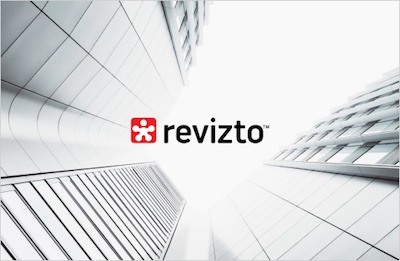What is a BIM model? Revit BIM model websites explained

What is Revit?
It is important to remember that, in essence, BIM is a process, while Revit is a software application. So, what is BIM in the context of Revit? BIM is often represented as a massive process that uses a plethora of different tools on different stages of a specific project, and Revit is one such tool. BIM itself does not design anything. Revit does that instead.
What is Revit, then? It is BIM software that allows users to use drafting elements and parametric modeling in the design process. In essence, a Revit BIM model contains the entire life cycle of a building or project (from conceptualization to daily use and deconstruction). Revit’s relational database architecture is what makes it all possible (Revit’s creators call it a “parametric change engine”).
There is another way of looking at this: Revit’s 3D BIM models can be referred to as both “BIM” and as “Revit models,” and both of these definitions are technically true. The 3D model in question is designed for BIM by interacting with Revit as a piece of software. The answer to the question “What is Revit?” in this case is still “a software application.”
Advantages of Revit BIM models
Compared with its predecessors in the form of 3D modeling software, Revit has quite a lot of advantages, with three of the biggest being:
- Parametric data. Often described as the core function of Revit, parametric data is the ability to add (embed) various parameters to each and every 3D model, whether it is energy use, geometric constraints, manufacturer information, material type, and so on. This allows designers to completely eliminate boring and repetitive tasks aimed at finding information that is already in the Revit model and leaves more time to spend on actual design and planning.
- Project collaboration. One of Revit’s biggest selling points is the ability to collaborate with as much efficiency as possible, no matter if you are linking Revit models, working within a LAN network, or using any other form of collaboration. Revit allows teams and team members to interact with each other in many different ways that contribute to the completion of the project.
- Design versatility. Since there are many people that call Revit “3D CAD” at first glance, it is important to mention that Revit is so much more than that. It allows users to manipulate project views in many different ways, including different perspectives, structural and floor plans, elevation perspectives, and even the ability to render an entire project in the middle of a workflow to preview specific parts of the project, which is why both virtual reality (VR) and augmented reality (AR) are used quite often in combination with Revit.
Revit is a massively useful software application used by designers, contractors, architects, and MEP engineers to generate Revit BIM models with an exceptional level of detail and an outstanding list of features.
Revit BIM models and how they differ from 3D models.
There are two main ways to refer to a complete set of documents in the construction industry: an information model or a data set. It would be incorrect to refer to BIM as an entity or physical object, since BIM is more of a process or way of working.
First, some background information is necessary. The process of building information modeling consists of multiple project teams contributing both data and information about the project, and they do all of this within a specific digital space: a common data environment (CDE).
There is a variety of types of information that can be contributed to a project, from schedules and cost plans to specifications and drawings. Drawings are also essential, created in three dimensions by different teams or different members of said teams. It is not uncommon for different 3D drawings from the same team to be put together as a singular 3D model and double-checked for coordination between the different drawings before the entire new model is shared with other teams.
One thing that is different with BIM is that the information contributed is usually connected to the general 3D model of the project so that members can access said information whenever they want it simply by clicking on the 3D model or object in question. For example, a single light might give you information about its manufacturer, cost, performance, lead-time, and much more.
This is the main difference between BIM model and 3D models: BIM models combine the model and information, while 3D models are simply models with no data to support them.
This connection between the models and the information is what makes BIM models so much more efficient, since information about the model is just one click away most of the time. The ability to have accurate information about parts of the model quickly and efficiently improves the effectiveness of the entire project in many different ways, from construction of higher quality to more accurate cost and time estimates.
Challenges of implementing Revit BIM models
Many of the shortcomings of this format are similar to those that companies face when implementing BIM solutions from scratch. For example, the issue of the construction industry’s extreme conservatism is still relevant to many companies, and many managers assume that the implementation of BIM is not necessary to achieve better results.
There is also the fact that BIM itself is a very sophisticated methodology, and something as seemingly basic as implementing Autodesk Revit can require a substantial amount of time and resources. Training your entire team is also worth bringing up here, since all users have to learn how to use software such as Revit, and it is notoriously difficult for newcomers.
Some other disadvantages are related directly to Revit itself and not to the BIM methodology. For one, while Revit does support a number of different file types, its full capabilities can be used only within the realm of a proprietary file format, which drastically limits interoperability if another project participant uses BIM software that does not work with Revit’s formats.
All of this and more needs to be kept in mind when reviewing all the advantages of Revit BIM models, since this approach is not without its shortcomings, and some of these may be quite drastic and significant.
Now that we are familiar with BIM models as a whole, let us take a look at Revit and its Revit families.
Top 20 sites to get Revit families
In this article, we’ll go over the top 20 sites to download Revit families off of.
1. Blocks

Blocks is an online platform for architectural content, and it is extremely popular among AEC professionals. It provides a curated collection of Revit families to choose from and download, although it only allows downloads of entire collections instead of specific families. Registration is required before downloading, and it is also necessary to install a free plugin to be able to download any of the libraries. The library is created for avid Revit users, with a large library of families that are either manufacturer-specific or generic, presented in a relatively convenient interface with filtering capabilities. While the service does have a free subscription tier, it is somewhat limited in its capabilities, and access to the entire library requires a paid subscription.
Advantages:
- Many verified Revit families for different purposes and professions.
- Choice between generic models and a selection of manufacturer-specific content.
- A portion of the library can be used without payment, although it is still necessary to register and to install the plugin.
Shortcomings:
- The total size of the content library is considerably smaller than most community-driven platforms in the industry.
- The resource only supports Autodesk Revit and Revit families, so it cannot work with other BIM solutions.
- The recent switch to a plugin-centric structure drastically reduces the service’s convenience because users cannot access models online.
Pricing:
- Blocks offers both a free tier and a paid pricing plan.
- The free tier provides limited access to the Revit content library and a number of manufacturer-specific libraries.
- The paid pricing plan is “Monthly Premium,” which costs €9.99 per user per month. It provides the complete Revit content library, new Revit families every week, and more.
- The “Annual Premium” plan, with a price of €99.90 per user per year, offers the same value proposition as the “Monthly Premium” plan. However, it is paid for annually, which is why it is cheaper than the month-to-month option.
2. BIMsmith Market
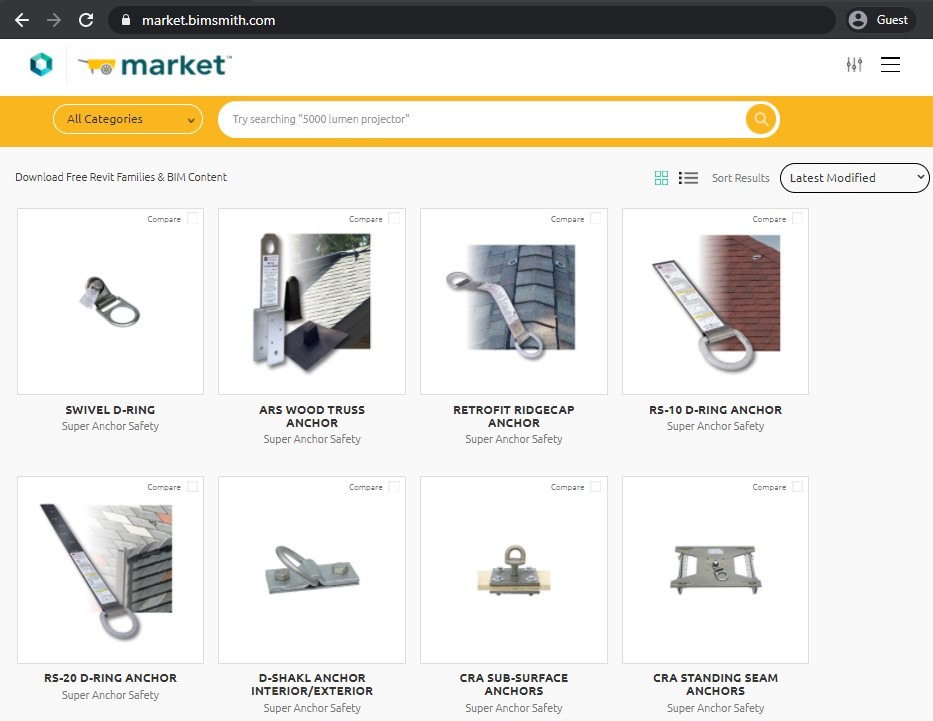
BIMsmith is a rapidly growing BIM platform that offers an impressive amount of information for AEC professionals. BIMsmith Market is the platform’s substantial library of thousands of free Revit BIM models. The website offers several different search filters and viewing modes, making it much easier for the end user to browse Revit Families. The platform serves as a centralized information hub for simplified sharing of BIM objects, and it even provides built-in object creation capabilities hosted in the cloud. Other capabilities of BIMsmith include a substantial emphasis on collaboration, a variety of educational and learning materials, and a detailed verification process for each object to ensure its overall quality.
Advantages:
- Works with Revit families and multiple other BIM file formats.
- Plenty of objects and models to choose from, both generic and manufacturer-specific.
- A selection of other capabilities is also available, including product specifications, object comparisons, and detailed project data for every model in the database.
Shortcomings:
- Due to the variety in quality standards, the quality of the manufacturer models may vary significantly from one manufacturer to another.
- The potential selection of generic BIM objects is drastically limited due to BIMsmith’s significant focus on manufacturer-centric models.
Pricing:
- Free account registration is the only requirement for an average user to access the entire object library.
- The website is most likely paid by manufacturers who want to promote their products and include their models in the catalog.
3. RevitCity
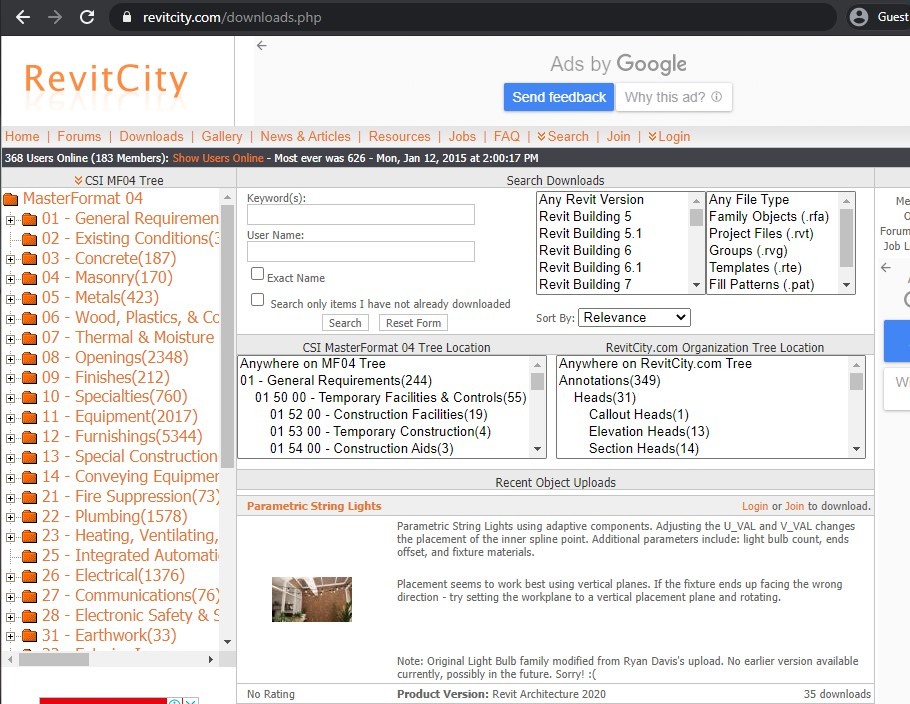
RevitCity is considered less of a content website and more of a community hub, especially when compared with the other examples on this list. As its name suggests, it is a content library focused solely on Autodesk Revit. Aside from its original purpose of downloading free Revit families, RevitCity also offers several other functions, including idea sharing, question answering, and finding the content you have been looking for. Finding content in specific formats or for specific versions of Revit is made possible by the resource’s filtering capabilities. The website might not look very modern, but the content library is rather formidable, with most of the models presented completely free of charge. There is also an option to post Revit-related jobs on a separate page on the website, although it is available only to users with a special status.
Advantages:
- Impressive content library of Revit families and models.
- Built-in forum for easier discussion of industry-centric topics, and even a separate “Jobs” page that can be used for recruitment purposes.
- The large and resourceful community built around RevitCity serves as a great addition to the website’s services, with new content being made available regularly, and offers several other advantages.
Shortcomings:
- The platform relies solely on user-generated content, which means that the quality of that content likely varies significantly from one model to another.
- Because the entire resource revolves around Revit, it is practically impossible to use it in combination with other BIM software.
- While each uploaded model undergoes some form of basic verification, there are no strict standards for the BIM models uploaded to the website. This may make it more difficult to find specific content due to misaligned meta tags or other standardization issues.
Pricing:
- A RevitCity membership is completely free. The only requirement is a basic account creation process that requires only a name and an email address.
- Additionally, there is an option to support resource creators using a donation button, but all donations are completely optional.
4. ProdLib
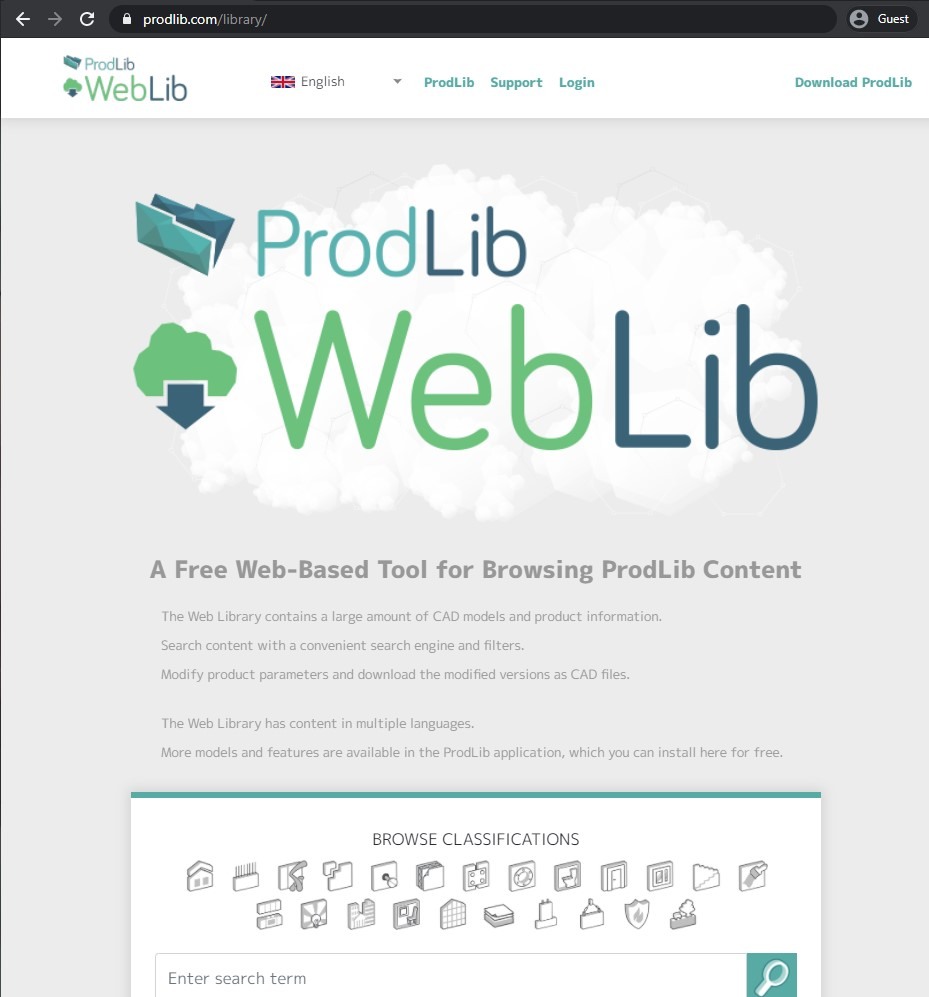
What is BIM in Revit when it comes to ProdLib? It is a highly useful product library that offers Revit family management capabilities, with the addition of a free web library full of Revit BIM models from a specific list of manufacturers. There are many different categories to work with, and the software itself makes interaction with CAD models a lot easier. ProdLib also draws many of its models directly from the manufacturers, ensuring they are as accurate and useful as possible. ProdLib’s product models can also be integrated into various CAD or BIM products due to its selection of specialized add-ons and plugins. It is another great example of a convenient platform that simplifies information exchange between manufacturers and AEC professionals.
Advantages:
- User-friendly interface with detailed filtering capabilities to simplify the process of searching for a specific BIM model or Revit family.
- Guarantee that all manufacturer models are up-to-date, since they come directly from their creators.
- Abilities for integration with multiple BIM or CAD solutions using plugins and add-ons.
Shortcomings:
- The overreliance on manufacturer-specific content directly translates into a lack of generic BIM models and Revit families, which may be necessary to some users.
- It is rather difficult to grow a community around a service that offers practically no feedback options.
Pricing:
- The models themselves are presented for free and can be downloaded with no payment required.
- There does not seem to be any kind of subscription mentioned on ProdLib.
- The resource most likely requires payment from manufacturers to place their products on the catalog.
5. Concora Product Information Library
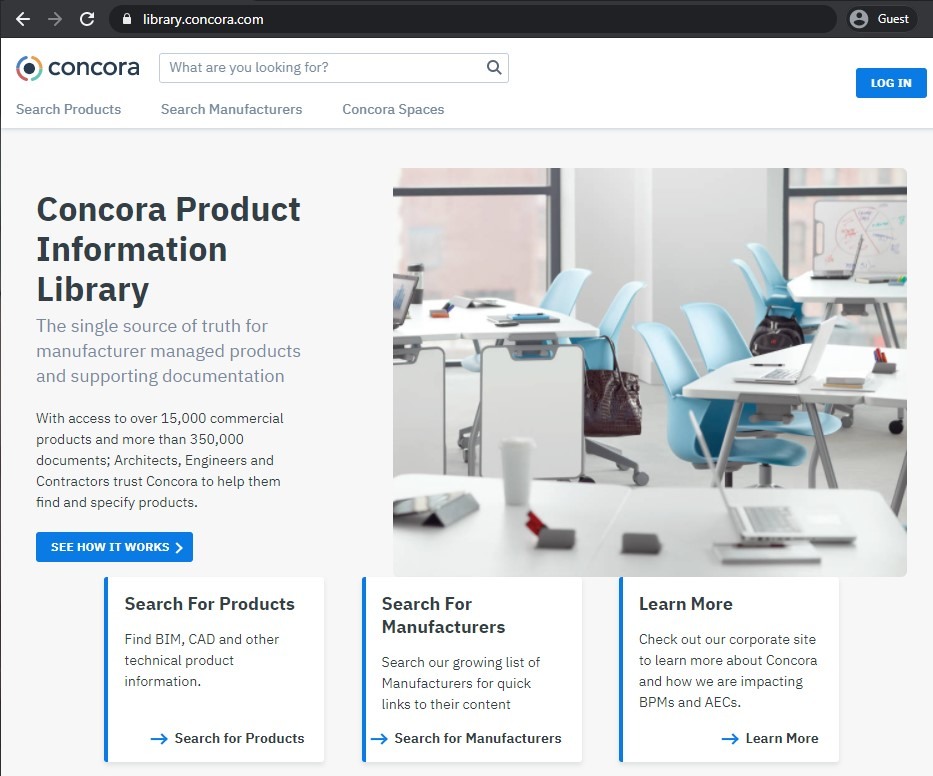
Concora is another Revit family sharing site with manufacturer-specific and generic content to choose from. The platform makes it easy to look for specific products or specific manufacturers, and the overall site design is incredibly user-friendly, with many Revit blocks to choose from. Concora provides a large selection of curated BIM objects with an abundance of data in each and every one of them. The platform offers abundant information about products and their manufacturers, going beyond BIM models to documentation and other helpful information. No payment is required to download the models, but the manufacturers most likely have to pay for their products to be part of this library.
Advantages:
- Plenty of BIM objects directly from manufacturers.
- There is a substantial amount of information assigned to each BIM model and object.
- Extensive filtering capabilities and the ability to look for object and manufacturer names make overall navigation relatively simple.
Shortcomings:
- The entire platform is composed of manufacturer-centric objects with no generic BIM models to choose from.
- The somewhat confusing pricing model makes it difficult to understand what offerings are included in the subscription.
Pricing:
- Concora itself is a paid solution with multiple elements, but the official website lacks information about the specific features of its pricing tiers, which makes for a rather problematic first impression.
6. Modlar
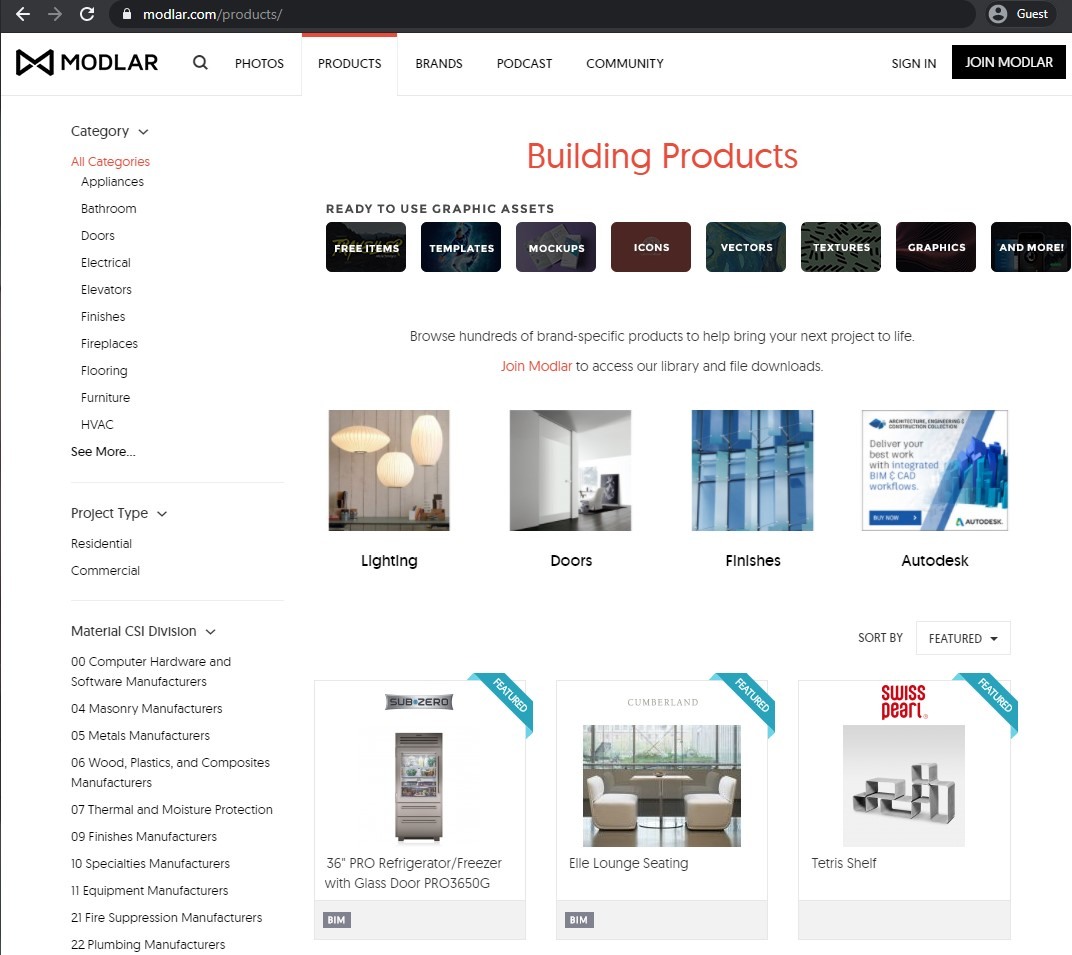
Modlar specializes in manufacturer-specific products, and it requires users to sign in to download files. It boasts a long list of different categories for its Revit objects and an overall nice and clean design. All of its contents are thoroughly checked and double-checked to present the highest-quality BIM models from some of the best manufacturers on the market. Modlar is a great source of information for designers and architects with highly detailed models and objects that offer plenty of information for each object. This information is incredibly important for performing various estimates and calculations. Modlar can even act as a social networking platform for designers and architects, with the ability to showcase projects, connect with other professionals, and even interact with manufacturers directly.
Advantages:
- A lot of manufacturer-centric content to choose from.
- Extensive product specifications and other object-related information are attached to each model.
- Thorough vetting and scanning systems ensure the quality of each model in the library.
Shortcomings:
- The library’s lack of user-generated content means that customers must use other resources to obtain generic BIM models or Revit families.
- The abundance of options in the library does make it difficult to navigate, especially for newcomers.
Pricing:
- Modlar is free to end users.
- It is unclear whether manufacturers must pay to have their products included in the library.
7. SpecifiedBy
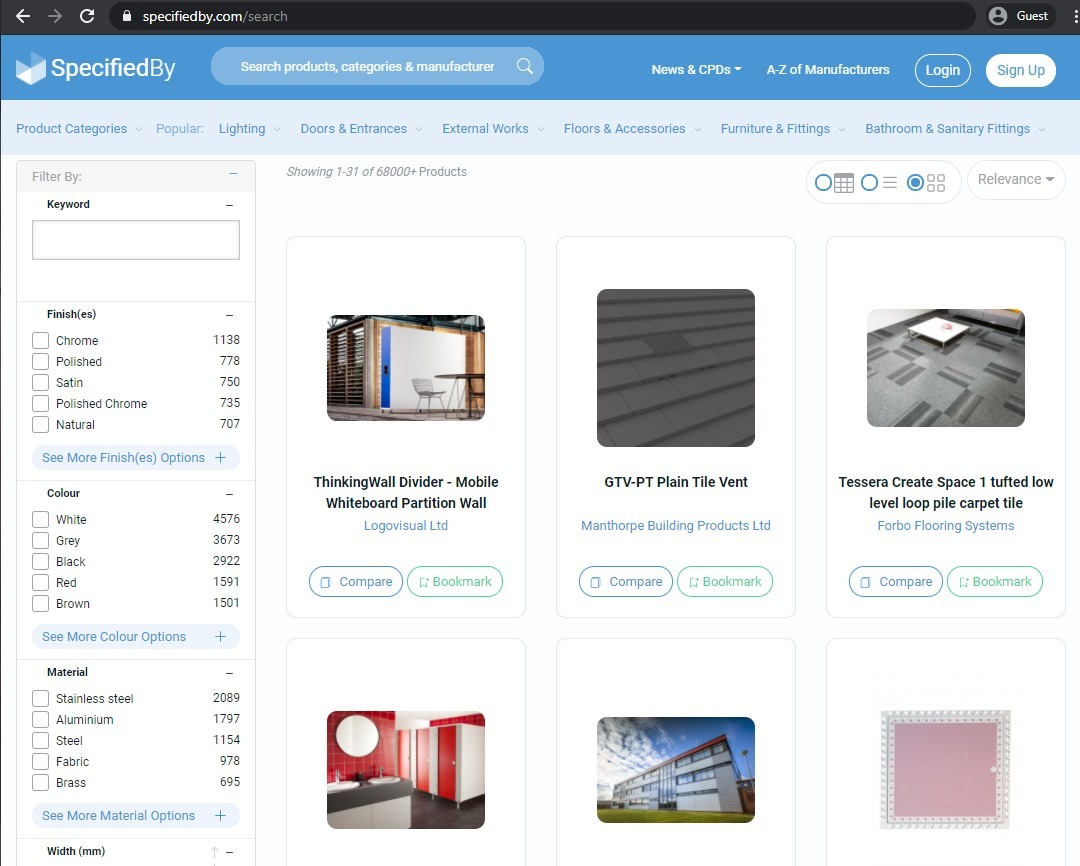
SpecifiedBy is a sizable online platform created to host building-related information in the construction industry, including technical data and product specifications. It is also the largest BIM content library in the UK, with many search filters and overall easy navigation. The ability to compare and/or bookmark the objects you like improves the overall user experience, and the selection of Continuing Professional Development materials in the form of webinars and other material offers a great source of information for the latest trends and standards in the industry.
Advantages:
- User-friendly interface with multiple filtering options.
- High accuracy of the average product model due to the specialization of the website and its high vetting standards.
- Continuing Professional Development resources that are provided alongside the BIM objects.
Shortcomings:
- It focuses entirely on the United Kingdom’s market, which significantly limits its reach worldwide.
- The regional limitation also makes the library relatively small compared to resources that include models without region locking.
Pricing:
- SpecifiedBy is free to end users such as AEC professionals and other specialists.
- However, manufacturers most likely must pay to place their objects in the library, although it is difficult to find information about this in public sources.
8. ARCAT
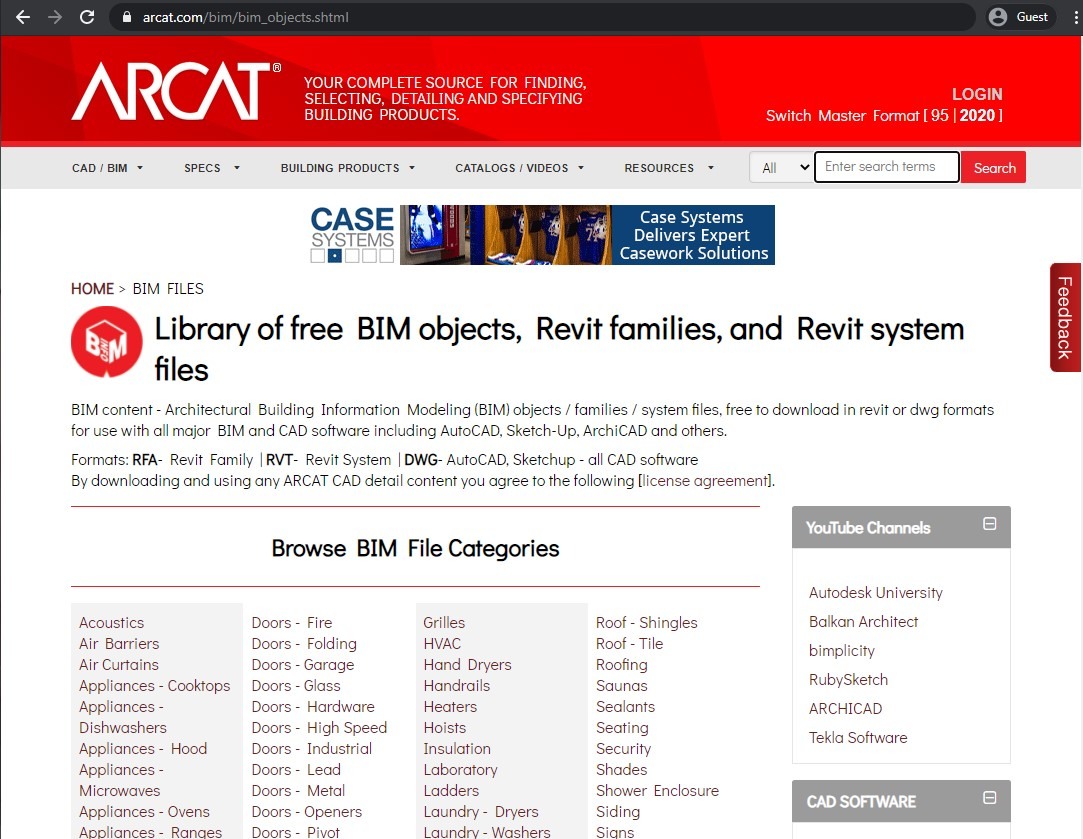
ARCAT is an interesting resource for AEC specialists with plenty of helpful information. It hosts resources for CAD and BIM software that can be accessed with very few limitations. There is a long list of categories available, as well as some supplementary resources, such as continuing education courses, learning materials, recent industry news, and so on. The platform also includes product specifications, object data acquired directly from manufacturers, and several other forms of information. There is even a dedicated specification writing tool from ARCAT (although the full version of the tool must be paid for separately).
Advantages:
- Complete availability of all library content with no limitations aside from the initial account registration.
- Substantial selection of information, including CAD models, BIM objects, specifications, and more.
- A separate section of the website hosts educational materials, including many recent trends and changes in the construction field.
Shortcomings:
- The sheer volume of content available does leave a lot of potential for lower-quality content due to the inconsistent quality standards from one manufacturer to another.
- The resource’s user interface is somewhat dated, although there are a few examples on this list that look even more outdated.
Pricing:
- ARCAT is completely free for the end user.
- Its revenue most likely comes from a combination of advertising and manufacturer object placements.
9. Diane Butterworth

Diane Butterworth is a company of professionals in the digital content industry, offering plenty of services and features to choose from, including BIM, rendering, material editing, planning, design, and more. They offer specialized Revit family creation capabilities, as well as a selection of Revit families hosted on their own website (acquired from different manufacturers). The library selection is somewhat limited, and there are practically no filtering options to choose from, but the fact that all of them are drawn from specific manufacturers offers a rather notable quality bar for the majority of models.
Advantages:
- It is focused entirely on manufacturer-centric content, offering a choice of many brands and companies.
- Customized Revit family creation is an option for an additional fee.
- Plenty of other capabilities, such as design, BIM consultation, and more.
Shortcomings:
- Little to no filtering and limited visualization for all objects in the library.
- It is focused entirely on Revit, with no support for other BIM or CAD solutions.
Pricing:
- Diane Butterworth offers several solutions with separate price tags.
- The library of Revit families is the only feature that is available for free.
- If a custom family is required, there is a separate price tag that varies on a case-to-case basis.
10. CADdetails
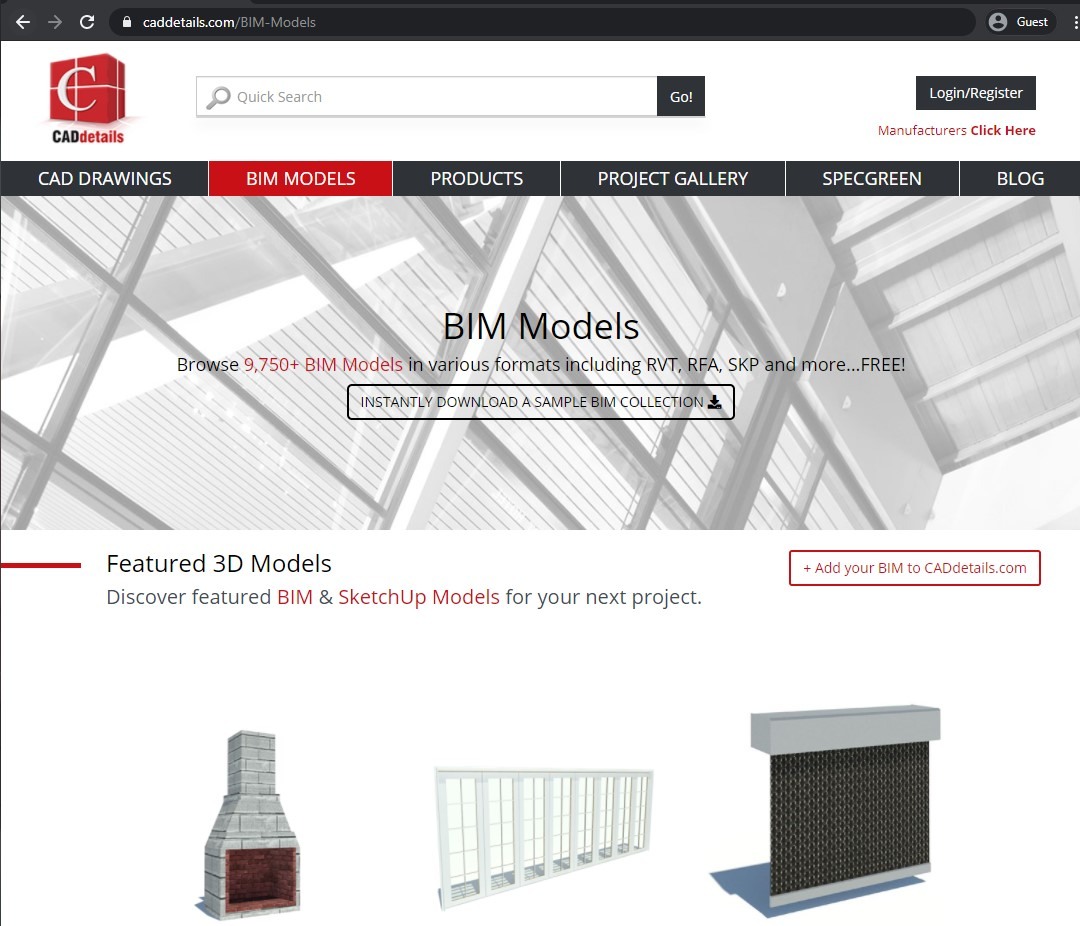
CADdetails is a well-known resource in the AEC industry, which many architects and designers are at least aware of. It offers industry-specific content in the form of models for Revit and SketchUp while also providing a decent selection of manufacturer-centric objects. The ability to filter the content based on product type or file format significantly simplifies the overall navigation, as does the existence of content categories. CADdetails also hosts entire product families or object groups from manufacturers, as well as product specifications and even a selection of completed projects as case studies to draw inspiration from.
Advantages:
- Support for both 3D models and 2D drawings, both of which can be downloaded for free.
- Substantial selection of manufacturer-specific information in addition to the models themselves.
- Impressive library size, including thousands of placements of different model groups.
Shortcomings:
- Most of the library is CAD content, which somewhat limits the selection of BIM information and objects.
- Although it is claimed that the entire library is curated, its sheer volume does leave some room for potentially low-quality content to be found.
Pricing:
- The entire product library is available to regular users for free. It is unclear whether manufacturers have to pay to have their products included in the library.
11. MeasuredSurvey365
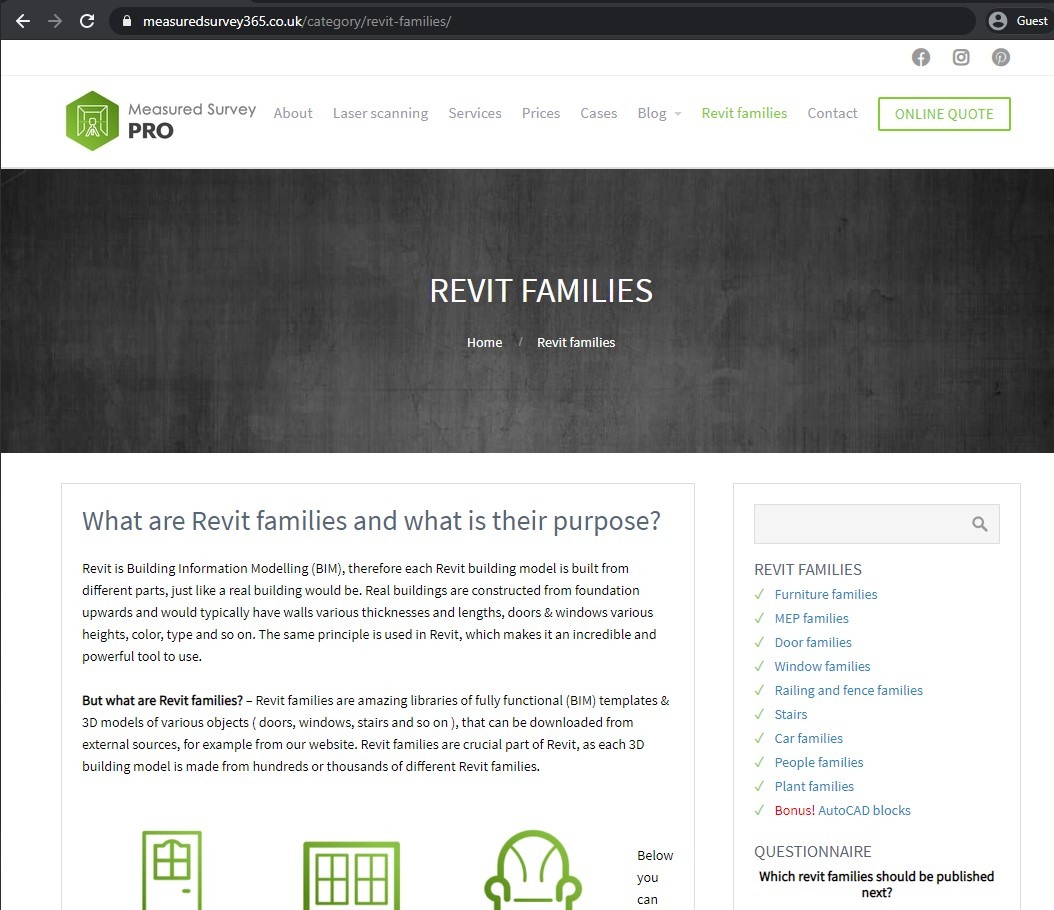
MeasuredSurvey365 is a dedicated service with a very telling name. It provides thorough surveying capabilities in several different forms. The service combines traditional survey methods with the newest technology to create extremely accurate project measurements for restoration, renovation, adaptive reuse, etc. The website also provides a good selection of Revit Families for free, separated into many different categories in a user-friendly and convenient interface. Some of the more common examples of models that can be found in this library are car families, plant families, railing families, and more.
Advantages:
- High measurement accuracy due to the ability to combine traditional and modern features and capabilities.
- A moderately large selection of Revit families to choose from, even though it is not the primary purpose of the solution.
Shortcomings:
- A small library of BIM objects compared with other resources in the market.
- A significant portion of potential users of the library would not visit the website to begin with due to its substantial focus on surveying and measuring capabilities.
Pricing:
- While the measuring services do have a separate price tag, pricing is not available to the public due to the large number of factors that affect the total cost.
- Revit families, on the other hand, are provided free of charge to all users.
12. BIMobject
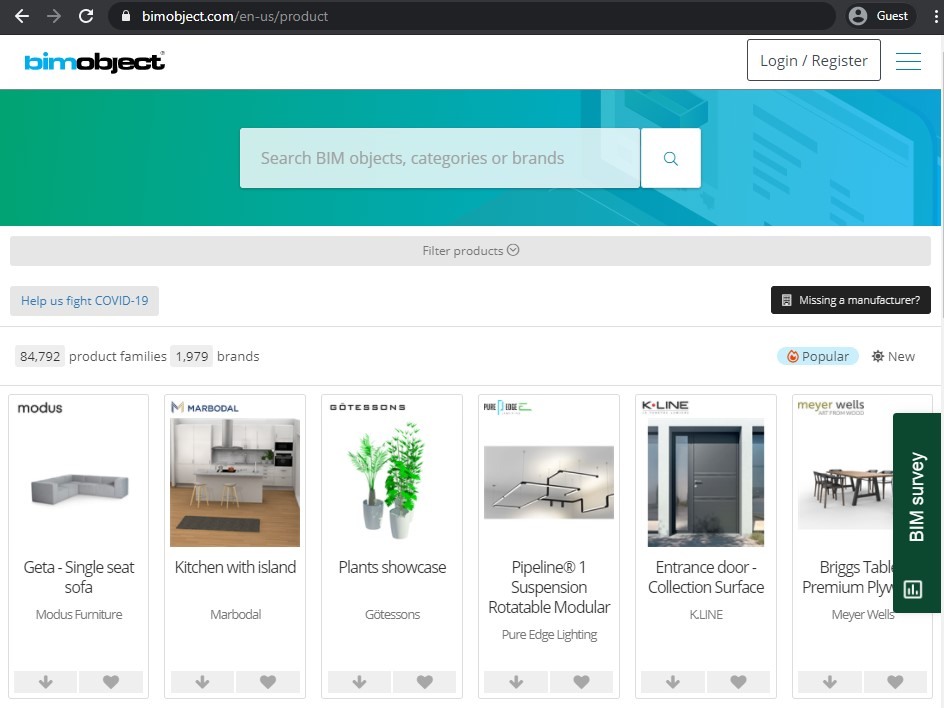
BIMobject is an extensive library of BIM-related content for different use cases. It is known as one of the fastest-growing digital content management systems for Revit BIM models on the market, currently providing tens of thousands of product families. The platform allows for the products to be filtered based on brand, file type, object category, and region. It can be a great help to engineers, architects, and many other professionals, with a centralized location for gathering product information and a user-friendly interface. Other capabilities of the platform include cloud-based collaboration tools and the ability for manufacturers to present their own products in the library.
Advantages:
- A large selection of BIM-related content, including support for different BIM software data formats.
- Easy information sharing between project teams thanks to BIMobject’s built-in collaboration tools.
- Offers both generic and manufacturer-specific content with an easy filter to find each of the categories.
Shortcomings:
- The sheer volume of models available and the relative ease of uploading project models most likely creates inconsistencies in terms of overall model quality.
- The large content volumes may be an overwhelming factor for new customers.
Pricing:
- BIM models from the service can be downloaded for free.
- BIMobject offers three different paid pricing plans to manufacturers, though there is a clear distinction between the business-related licensing options:
- “Lite” offers the basic capability of hosting BIM models on the website and managing them conveniently.
- “Essential” provides moderately versatile content analysis tools, offering a selection of useful insights into the performance of your BIM content.
- “Pro” is the complete feature set of the service, improving upon the marketing toolset while also providing automation capabilities and plenty of other features.
13. NBS National BIM Library

NBS National BIM Library is the self-proclaimed fastest-growing BIM library in the UK. It offers a strong selection of both generic and manufacturer-specific BIM objects. Other capabilities of the service include object filtering, various categories, and several other ways of simplifying website navigation. Although the NBS BIM library supports manufacturer and user-generated objects in the same place, many of its models also meet the NBS BIM Object Standard, which is represented by the “BOS icon” on the website. The resource also offers a dedicated plug-in for Autodesk Revit, dramatically reducing the time and effort it takes for objects to be exported from the library to the BIM software.
Advantages:
- Moderately sized library of both generic and manufacturer-specific BIM objects to work with.
- The platform’s ruleset includes a thorough vetting process to ensure that objects meet specific compliance frameworks, such as the NBS BIM Object Standard.
- Plenty of learning materials on the website, as well as guidance on different aspects of BIM implementation.
Shortcomings:
- Complete focus on the UK market and its standards, limiting the potential reach of the resource in other locations.
- Plug-in integration is available only for Autodesk Revit, which is logical but may be rather annoying to businesses that use other BIM solutions.
Pricing:
- The entire library is available to end users for free. The resource also offers its services to manufacturers who want to add their products to the library. However, the pricing model of that offering is not available to the public.
14. TurboSquid
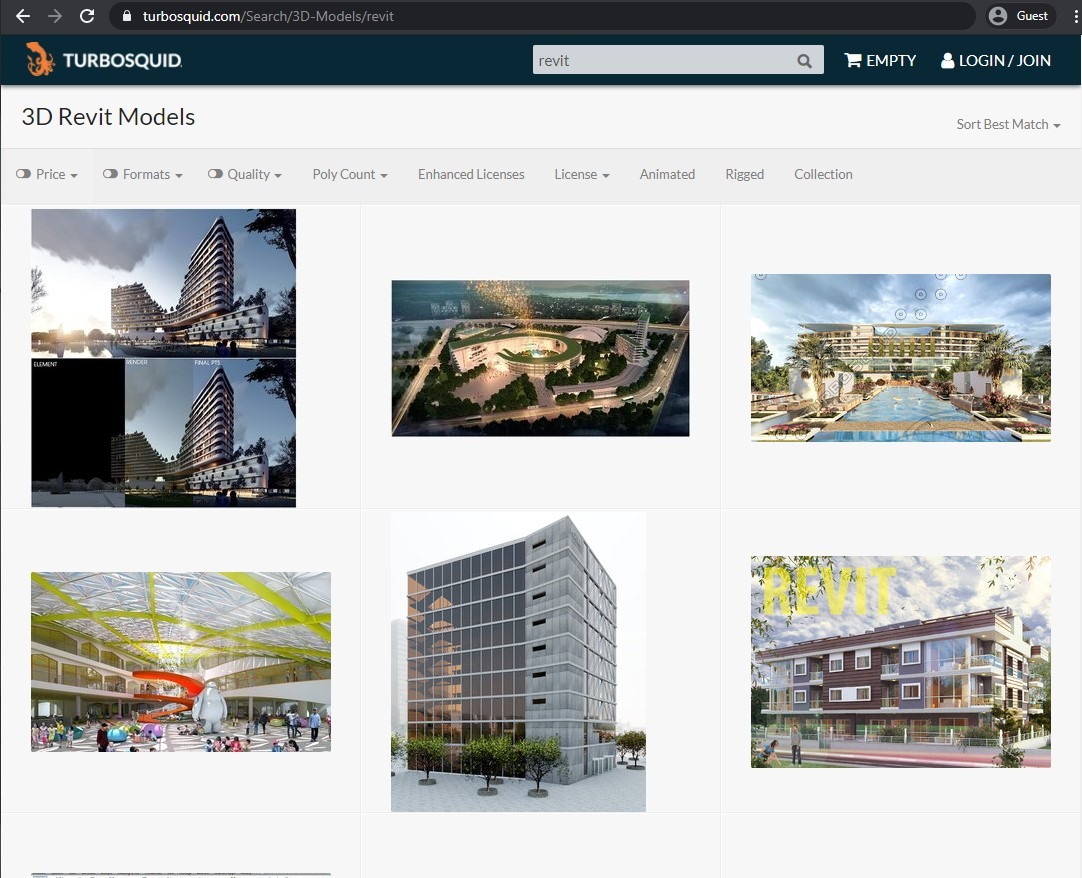
TurboSquid (owned by Shutterstock) is a rather sizable online marketplace for models and objects in a specific format. The platform includes both paid and free objects and models, allowing its users to set their own prices for models. Most of the catalog is therefore relatively cheap. The basic filtering capabilities allow users to filter out paid or free models with ease, and the ability to segregate models based on their file format is a great help in terms of overall navigation. The platform claims to have an elaborate curation process to ensure model quality and compatibility with the software it claims to work with.
Advantages:
- Outstanding library of objects for BIM software, CAD solutions, and even game engines such as Unity.
- Convenient filtering capabilities simplify the overall navigation, especially regarding basic search parameters.
- A useful marketplace for various 3D artists to sell their models and objects on their own terms.
Shortcomings:
- There are many objects and models for specific software solutions from both the CAD and BIM markets, but the number of BIM objects specifically is relatively low, and Revit families are practically nonexistent.
- Although TurboSquid uses its own algorithm to verify the authenticity of each model in the library, there is no guaranteed baseline for model quality from one manufacturer to another.
Pricing:
- Some models have their own price tags, while others are available for free. The choice is completely up to the model uploader.
- The average price of a model is relatively low, and the existing filtering options make it easy to search for paid options only or to filter the content to see only models from specific software.
- There are no resource-side subscriptions or paid options aside from the separate fee for manufacturers who want their objects placed in TurboSquid’s content library.
15. 3Dfindit

3Dfindit was previously known as BIM Catalogs. It is a dedicated platform for hosting and sharing manufacturer-specific content such as models and objects. The platform can be challenging to navigate without a specific manufacturer in mind. On the other hand, if you already have a specific manufacturer in mind, then the built-in filtering options can help locate their contents that much faster. There are no generic BIM models to choose from, since the platform focuses entirely on manufacturer-specific models and objects. There is also a selection of plugins that can be integrated with various CAD and BIM solutions to simplify the export of models from the library.
Advantages:
- Plenty of resources and models from a multitude of manufacturers.
- Support for several BIM and CAD file types.
- A selection of custom plugins for many solutions that simplify model exporting, including both CAD and BIM software.
Shortcomings:
- The overall web interface can be slightly difficult to navigate for most newcomers.
- The abundance of manufacturers does lead to the possibility of inconsistent quality from one model to another due to the variety of standards each manufacturer has.
Pricing:
- The entire library of 3Dfindit is available for free to end users.
- Manufacturers likely pay the platform for their objects to be placed in the library.
16. Polantis

Polantis is a convenient content library platform from the previously mentioned BIMobject, offering an entire library of objects and models directly from manufacturers. It provides a lot of 3D content for Revit, although the Revit families here are not “true” families, because they are mostly created with other 3D software and then converted to the Revit family file format. Nevertheless, there is a lot of free content in various categories, and there is also support for a multitude of software types, including both CAD and BIM solutions. There is no clear information about this on Polantis’ public website, but there is most likely a way for manufacturers to place their objects on the platform. It is also highly likely that the placement of objects requires some sort of payment from the manufacturer.
Advantages:
- Support for content in many different formats, including both BIM and CAD software.
- Relatively high quality of the average model or object, since all models in the library are taken directly from manufacturers, and there are no generic models.
- Convenient filtering capabilities drastically simplify the navigation process, making it a lot easier to find the necessary objects or models.
Shortcomings:
- The relatively small selection of manufacturers presented in the library leads to a somewhat limited number of objects and models.
- The platform’s overall range of use cases is significantly limited due to its strong focus on interior design.
Pricing:
- All the models on the original Polantis website are available for free.
- There was also a marketplace on the website that let customers buy and sell BIM models, but it is now no longer there.
17. BIMbox
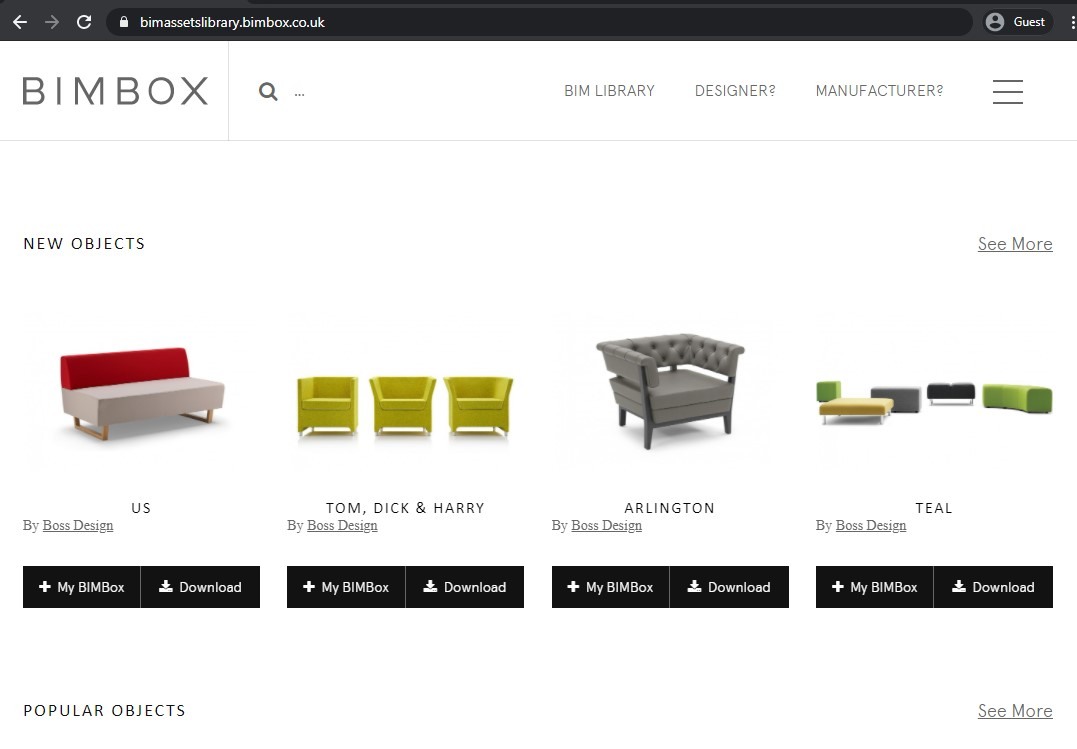
Since the UK was one of the first countries to push for country-wide BIM standardization on a government level, there are plenty of resources that are focused exclusively on the UK market. BIMbox is another example of such a resource. It has a moderate number of Revit BIM models available for free and several additional features, as well. The platform is focused primarily on interiors, and most content is IFC-compliant. Creating a BIMbox account also leaves an option of adding personal objects or models to a custom library (not visible to the public). Other capabilities include support for most major BIM formats and a requirement that all library content support Level 2 BIM (or higher) and COBie, setting something of a quality bar for all objects.
Advantages:
- Support for multiple BIM platforms and file formats.
- The focus on manufacturer-centric content sets a certain quality bar for all models.
- BIM content management solutions for brands and manufacturers are also available as a separate offering from the same company (which includes placing the client’s models in this library).
Shortcomings:
- The explicit focus on the UK construction market limits its potential library size worldwide.
- The website navigation can be slightly confusing and even overwhelming due to the large number of categories and subcategories available.
Pricing:
- The contents of BIMbox are free for designers and other end users.
- Manufacturers do have to pay a content creation fee and an annual hosting charge, although the exact pricing cannot be found on the official BIMbox website.
18. CAD Forum
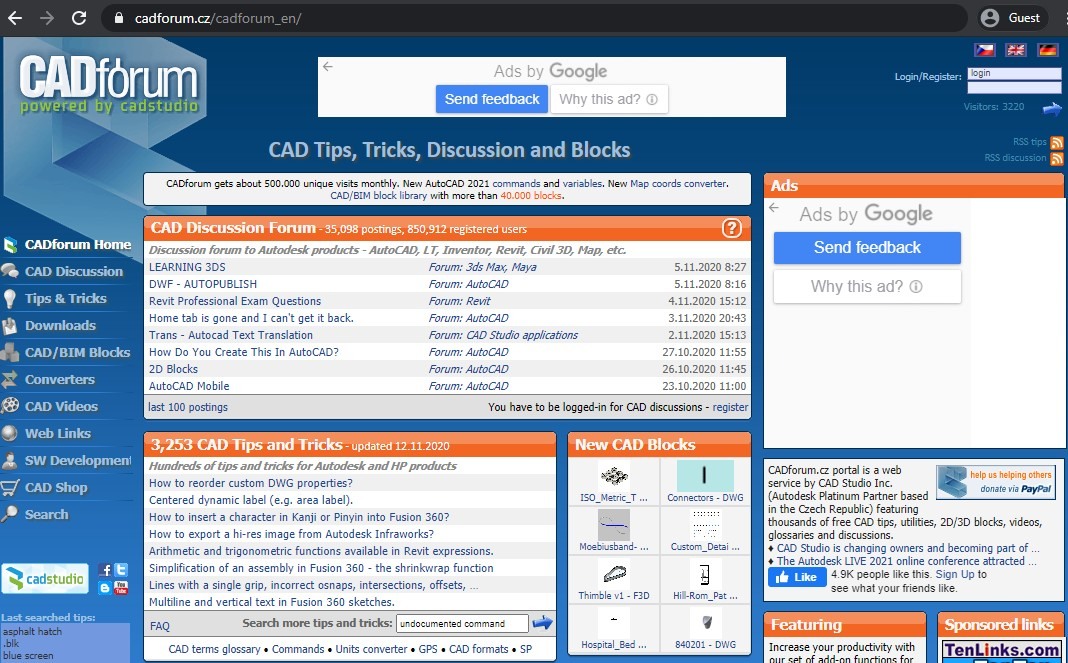
CAD Forum is a CAD/BIM block library with over 10,000 different blocks to choose from, and it also has a separate section with some tips for AutoCAD and Revit 2017. A resourceful community and a lot of other supplementary things are also included in the service. CAD Forum’s library of objects includes multiple forms of digital design assets for various professionals in the AEC industry, with user-contributed items placed alongside manufacturer-submitted ones. The resource also offers a separate discussion forum for knowledge sharing, as well as plenty of user-generated educational material on the topics of CAD and BIM.
Advantages:
- Impressive volume of different BIM objects, CAD models, and other forms of content in the AEC industry.
- Both the community forums and the catalog of user-generated content are used to grow the service’s overall community.
- There is a moderately large volume of educational content on the website alongside the BIM object and CAD model libraries.
Shortcomings:
- The presence of user-generated content in the catalog suggests that the quality of the models might differ drastically from one object to another.
- CAD Forum supports multiple forms of content and not just BIM objects, which can make navigating the library somewhat difficult, especially for newcomers.
Pricing:
- CAD Forum is completely free for all users.
- The website’s front page has an optional “donate” button, and there are also multiple other passive forms of monetization such as visual ads, affiliate links, etc.
19. BIMstore
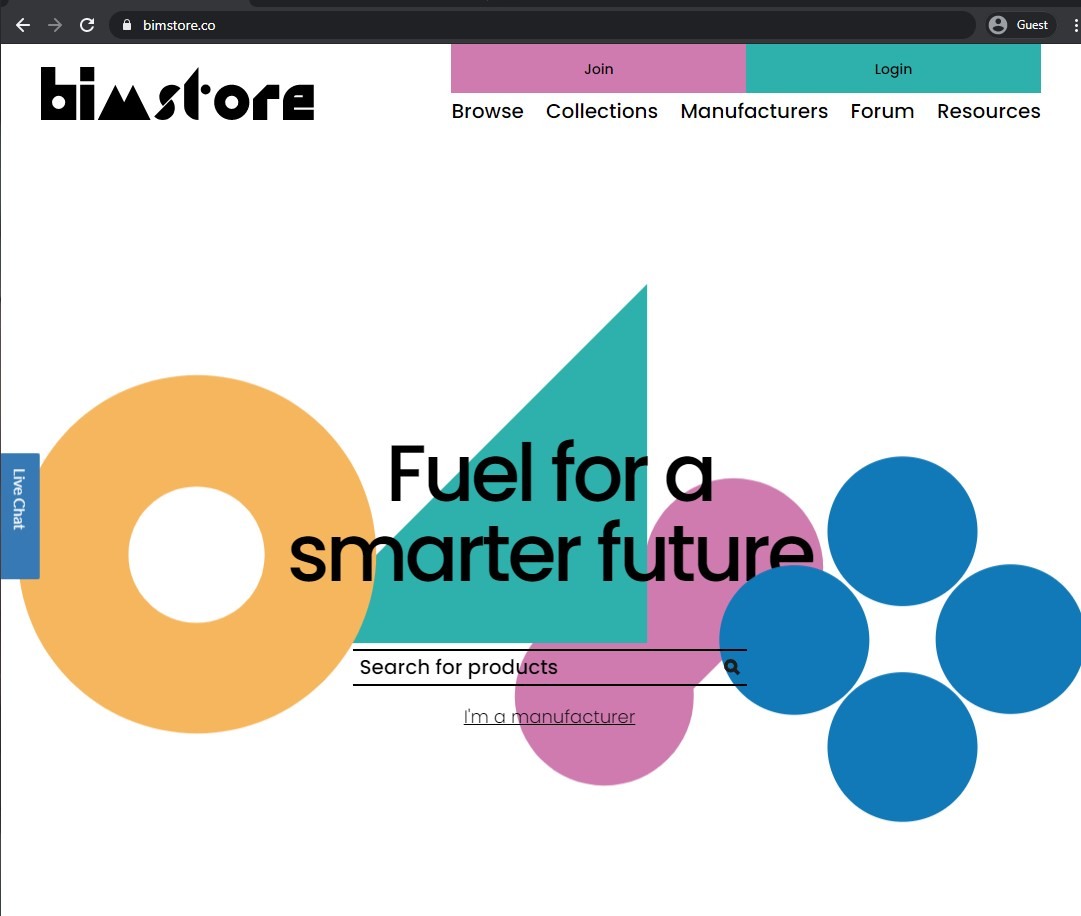
BIMstore is another answer to the question of “What is BIM in Revit?”. It is a BIM content library focusing on three primary examples of BIM software: Revit, ArchiCAD, and Microstation. Although it is necessary for end users to register to be able to download models, the library is completely free. There is plenty of content in this library, and the overall selection is both curated and changed regularly to introduce new manufacturers and model examples. Other capabilities of the resource include multiple curated collections of objects, a built-in collaboration tool, and even the ability to simplify the process of exporting models to Revit by downloading a free plug-in. BIMstore also offers recent news on both its products and the industry as a whole.
Advantages:
- Provides models and objects for several different BIM proprietary formats and not just for Revit.
- Much of the manufacturer content, in the form of BIM objects and product information, is curated and updated regularly.
- The platform’s community aspect includes the ability to comment on each model and give user ratings.
Shortcomings:
- The user interface can be slightly overwhelming and confusing, especially to newcomers.
- There are practically no generic BIM models to work with. The library focuses on manufacturer-centric content.
Pricing:
- All of the models in BIMstore are completely free. Manufacturers have to pay for their products to be presented in the library (the price is unclear).
20. BIMbits 3D Library
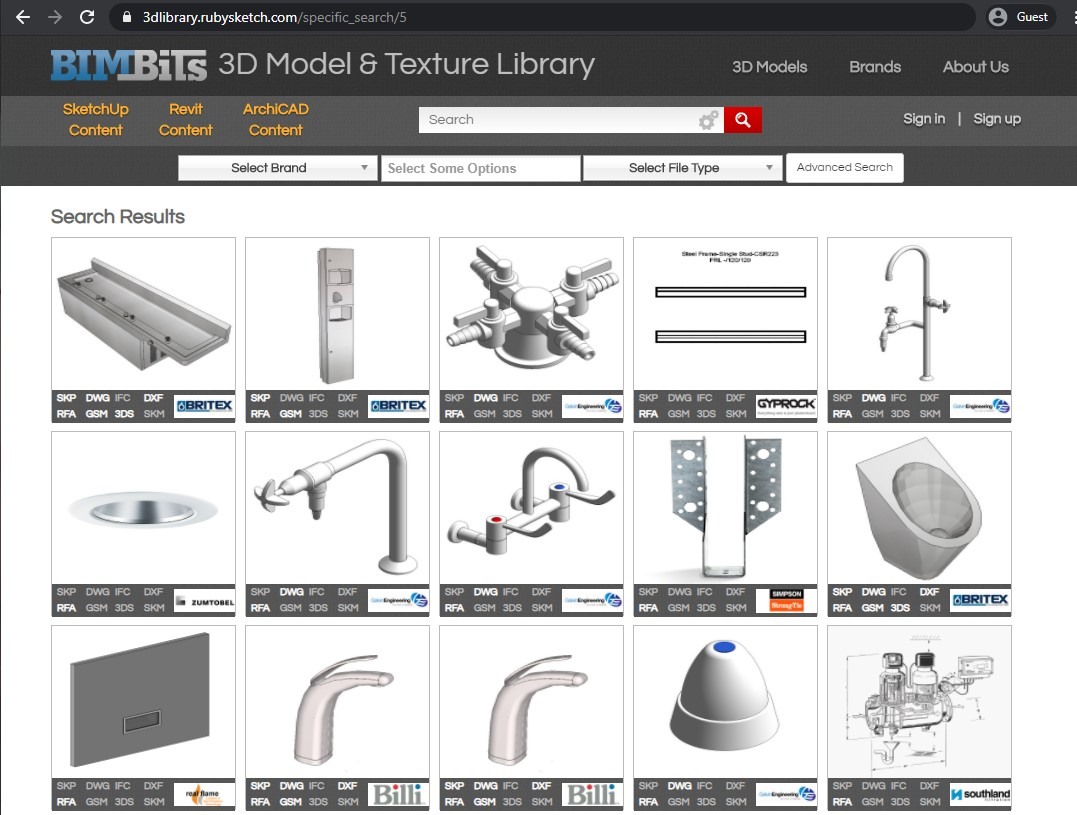
BIMbits 3D Library by RubySketch offers a considerable amount of BIM content for architects, designers, and other professionals in the field. The platform puts significant emphasis on architectural and MEP content, and most models are Revit-compatible as a basic requirement. BIMbits 3D Library works with at least three different categories of content, separated onto their own web pages: SketchUp, Revit, and ArchiCAD. The total range of objects and models available is rather substantial, and there are also plenty of filtering capabilities, including by file type, brand, and so on. Each file can also be downloaded in multiple different software-specific file formats, and the entire library is available free of charge for end users.
Advantages:
- Support for multiple software types and file formats, with three large sections for SketchUp, Revit, and ArchiCAD.
- Detailed filtering capabilities can assist users with searching for specific BIM objects or Revit families.
- The entire library is free for regular users. Manufacturers can contact RubySketch to be placed in the library, as well.
Shortcomings:
- The UI can be slightly confusing to newcomers, especially regarding filtering options.
- The large number of contributors means that model quality most likely varies from one manufacturer to another.
Pricing:
- Completely free for all individual users.
- Manufacturers pay for their models to be included in the library.
The future of Revit BIM models
Revit models can greatly benefit from many of the present and future trends in the tech industry, considering that BIM as a whole remains one of the biggest changes to the construction industry in decades.
For example, artificial intelligence may provide multiple ways of suggesting helpful design improvements and automating repetitive tasks. The Internet of Things, on the other hand, may drastically increase the accuracy of information gathering capabilities from on-site objects through the deep integration of various sensors and other hardware in a single environment.
Virtual reality and augmented reality have already been used in the context of BIM software for a while, offering better visualization for BIM models and the ability to create stunning virtual walkthroughs for regular users, stakeholders, or clients. As such, the industry reacts quite well to new technologies, and the very nature of BIM implies that most of them will be implemented sooner rather than later.
The ongoing process of BIM adoption all over the planet will most likely continue to boost the popularity of Revit models and BIM software in general, offering more convenient access to real-time project information, a more convenient way to achieve sustainable construction, etc. It may also be a gateway for both modular construction and prefabrication to become more accepted and popularized, which may drastically improve the speed and simplicity of mass-producing standardized structures if the technology becomes widespread enough.
Conclusion
There are plenty of web resources and platforms that offer Revit families or other BIM models in some form or fashion. In the context of such a large selection of resources, it should not be very difficult to find one or several models you need for a specific situation.
Revit BIM models can offer substantial volumes of information, and using such models in a BIM project is a massive advantage in itself, since they are capable of streamlining communication and simplifying simulation processes and offer many other advantages.
Unlock seamless BIM collaboration — request your demo today

